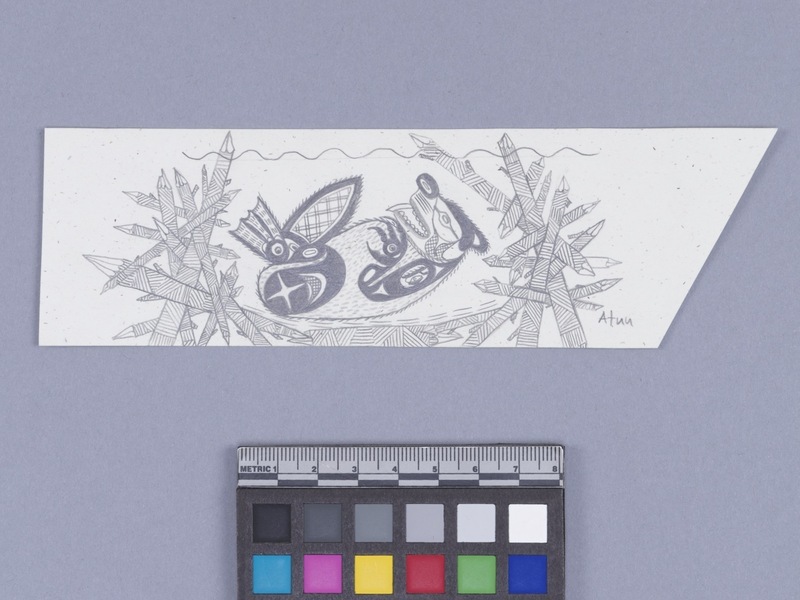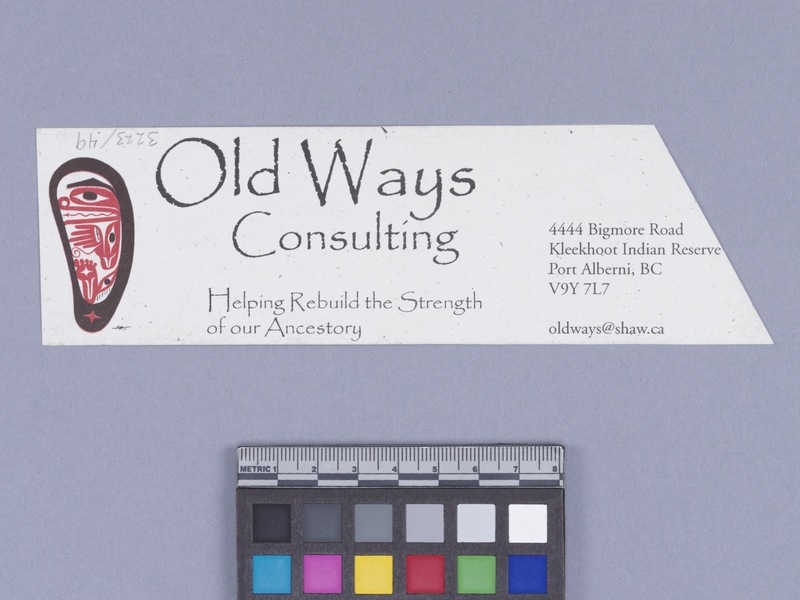Drawing Item Number: 3223/49 from the MOA: University of British Columbia


Description
A drawing on a whitish grey coloured bookmark. One end of the bookmark is cut at a forty-five degree angle. The front-side of the bookmark is horizontally oriented and is hand-drawn in pencil. The central image on the front-side of the bookmark is a beaver lying on its back in an underwater log dam. The logs surrounding the beaver are embellished with criss-crossing assemblages of grey stripes. The artist's signature is on the bottom-right-side of the image. The reverse-side of the bookmark is machine-printed in dark brown ink. On the left-side, an image of an enclosed human is printed alongside the artist's signature, a "M" with a line drawn through it and a dot on the top-left and bottom-right of the line. The centre and right-side of the bookmark lists commercial information including the agency's name, "Old Ways Consulting."
History Of Use
These 62 small works (3223/1-62) comprise a collection of drawings in pencil, ink, pencil crayon, and felt pen made by the artist between the years 1968 and 2015. During that period the artist has identified himself by the following names: Ron Hamilton; Hupquatchew; Ki-ke-in; Kwayatsapalth; Chuuchkamalthnii; and Haa’yuups. The drawings are, for the most part, applied to the backs of bookmarks acquired from a range of bookshops; some are applied to other pieces of paper or cutouts from his earlier silkscreen prints. Many of the images represent killer whales, often in conjunction with accoutrements and symbols of Nuu-chah-nulth whaling. The juxtaposition of bookmark and representation of Nuu-chah-nulth himwits’a, or narrative, is a deliberate and meaningful placement of two distinct knowledge systems in relationship with one another. Ephemeral drawings like these were not created for the market; the artist has long made them for himself and sometimes as gifts for relatives and friends; they are a way of sharing his knowledge and experience about Nuu-chah-nulth ways of knowing, thinking about, and being in this world; they are expressive of what he calls kiitskiitsa: marks made with intention.
Item History
- Made by Ron Hamilton (Maker) in British Columbia, Canada between 1968 and 2015
- Owned by Ron Hamilton before November 8, 2016
- Received from Museum of Anthropology Acquisitions Budget (Funding source), Michael O'Brian Family Foundation (Funding source) and Ron Hamilton (Seller) on November 18, 2016
What
- Name
- Drawing
- Identification Number
- 3223/49
- Type of Item
- drawing
- Overall
- height 5.5 cm, width 18.4 cm
Who
- Culture
- Nuu-chah-nulth: Hupacasath
- Creator
- Ron Hamilton (Maker)
- Previous Owner
- Ron Hamilton
- Received from
- Museum of Anthropology Acquisitions Budget (Funding source), Michael O'Brian Family Foundation (Funding source) and Ron Hamilton (Seller)
Where
- Holding Institution
- MOA: University of British Columbia
- Made in
- British Columbia, Canada
When
- Creation Date
- between 1968 and 2015
- Ownership Date
- before November 8, 2016
- Acquisition Date
- on November 18, 2016
Other
- Item Classes
- works on paper
- Condition
- excellent
- Current Location
- Case 9
- Accession Number
- 3223/0049